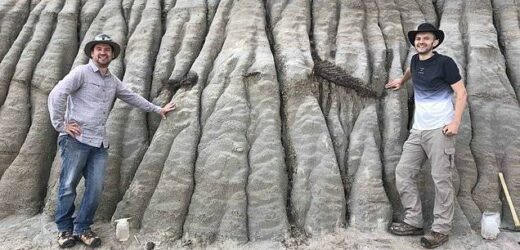A roarsome find! Fossil of a young duck-billed hadrosaur covered in scaly skin discovered in Canada could be a rare complete dinosaur skeleton, scientists claim
- The fossil of a hadrosaur – a ‘duck-billed’ dinosaur – has been found in a hillside
- Its placement suggests that the entire skeleton could be preserved within the hill
- All that can be seen is its tail and right hind foot, covered in fossilised skin
- The dinosaur species won’t be able to be identified unless its skull is uncovered
A dinosaur fossil discovered partially buried within a hillside could be a rare complete skeleton, researchers say.
The exposed fossil of a hadrosaur – a large, plant-eating, duck-billed species – was found in the Dinosaur Provincial Park of Alberta, Canada.
All that can be seen is a large portion of the tail and right hind foot, but the animal is sitting in a way that suggests the entire skeleton could be preserved within the hill.
Complete with fossilised skin, the remains were discovered during a visit by ecologists from the University of Reading in 2021.
As entire skeletons are very rare, the specimen is likely to provide information about what the dinosaur looked like and its anatomy.
Dr Brian Pickles said: ‘This is a very exciting discovery and we hope to complete the excavation over the next two field seasons.’
The exposed fossil of a hadrosaur – a large, plant-eating, duck-billed species – sticks out from a hillside in the Dinosaur Provincial Park of Alberta, Canada
Complete with fossilised skin, the remains were discovered during a visit by ecologists from the University of Reading in 2021
WHAT WERE HADROSAURS?
Hadrosaurs are known as the duck-billed dinosaurs because of the flat duck-bill appearance of the bones in their snouts.
They were large animals ranging from 23 to 26 ft (7 to 8 metres) and 2 to 4 tonnes (2,000 to 4,000 kg)
The species was plant-eating and lived from 75 to 65 million years ago.
Paleontologists say hadrosaurs may have been able to outrun a T-rex.
He added: ‘Based on the small size of the tail and foot, this is likely to be a juvenile.
‘Although adult duck-billed dinosaurs are well represented in the fossil record, younger animals are far less common.
‘This means the find could help palaeontologists to understand how hadrosaurs grew and developed.’
Hadrosaurs – a name derived from the Ancient Greek for ‘stout lizard’- are known as the duck-billed dinosaurs because of the flat bill-like appearance of the bones in their snouts.
They were large animals ranging from 23 to 26 ft (7 to 8 metres) and 2 to 4 tonnes (2,000 to 4,000 kg).
They were herbivores, and lived between 75 and 65 million years ago in the Late Cretaceous Period.
Examples of hadrosaurs include Parasaurolophus, which had a long, backward-curving crest on its head and appears in the 2022 film ‘Jurassic World Dominion’, and Edmontosaurus, that had a crest made from soft tissue like a rooster.
Dr Pickles was leading a search of the area when a volunteer crew member named Teri Kaskie noticed part of a fossil skeleton protruding from a hillside.
Dr Caleb Brown, from the Royal Tyrrell Museum, said: ‘Hadrosaur fossils are relatively common in this part of the world but another thing that makes this find unique is the fact that large areas of the exposed skeleton are covered in fossilised skin.
‘This suggests that there may be even more preserved skin within the rock, which can give us further insight into what the hadrosaur looked like.’
It may take several months to collect the entire skeleton, and once it is it will be delivered to the Royal Tyrrell Museum’s Preparation Lab, where technicians will work to uncover the fossil.
They will determine how well-preserved it is, whether the entire skeleton is there, and how much of the skin is preserved.
Identifying the exact species of duck-billed dinosaur will only be possible if a skull is discovered.
Based on the size and preservation of the specimen, fully preparing it for research and display may take several years.
In collaboration with the Royal Tyrrell Museum, the team is working together to excavate the skeleton while protecting the exposed fossil.
KILLING OFF THE DINOSAURS: HOW A CITY-SIZED ASTEROID WIPED OUT 75 PER CENT OF ALL ANIMAL AND PLANT SPECIES
Around 66 million years ago non-avian dinosaurs were wiped out and more than half the world’s species were obliterated.
This mass extinction paved the way for the rise of mammals and the appearance of humans.
The Chicxulub asteroid is often cited as a potential cause of the Cretaceous-Paleogene extinction event.
The asteroid slammed into a shallow sea in what is now the Gulf of Mexico.
The collision released a huge dust and soot cloud that triggered global climate change, wiping out 75 per cent of all animal and plant species.
Researchers claim that the soot necessary for such a global catastrophe could only have come from a direct impact on rocks in shallow water around Mexico, which are especially rich in hydrocarbons.
Within 10 hours of the impact, a massive tsunami waved ripped through the Gulf coast, experts believe.
Around 66 million years ago non-avian dinosaurs were wiped out and more than half the world’s species were obliterated. The Chicxulub asteroid is often cited as a potential cause of the Cretaceous-Paleogene extinction event (stock image)
This caused earthquakes and landslides in areas as far as Argentina.
While investigating the event researchers found small particles of rock and other debris that was shot into the air when the asteroid crashed.
Called spherules, these small particles covered the planet with a thick layer of soot.
Experts explain that losing the light from the sun caused a complete collapse in the aquatic system.
This is because the phytoplankton base of almost all aquatic food chains would have been eliminated.
It’s believed that the more than 180 million years of evolution that brought the world to the Cretaceous point was destroyed in less than the lifetime of a Tyrannosaurus rex, which is about 20 to 30 years.
Source: Read Full Article





